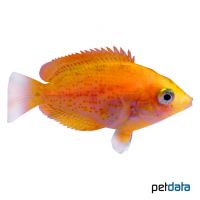Tangerine Orange Chromide (Etroplus maculatus 'Tangerine')
| Tangerine Orange Chromide Etroplus maculatus 'Tangerine' | |
|---|---|
| Name | Tangerine Orange Chromide |
| Name Lat. | Etroplus maculatus 'Tangerine' |
| Family | Cichlids |
| Family lat. | Cichlidae |
| Order | Cichlids |
| Order lat. | Cichliformes |
| Origin | South Asia (breeding variety) |
| Habitat | Estuaries, lagoons |
| Diet | Omnivore |
| pH | 8.0-9.5 |
| Behavior | Peaceful |
| Keeping | Pair, group |
| Care Level | Moderate |
| Reproduction | Substrate spawner |
| Breeding | Moderately difficult |
| Life Span | 4-6 years |
| Protection | No |
| Metric Units | |
| Size | 8 cm |
| Temperature | 20-28 °C |
| Hardness | 10-20 °dH |
| Aquarium | 80 cm / 110 l |
| US Units | |
| Size | 3.1" |
| Temperature | 68-82 °F |
| Hardness | 178-356 ppm |
| Aquarium | 30 gal |
Distribution and habitat
The Orange Indian Cichlid is a farmed form. The range of the wild form extends from the western Indian province of Maharashtra to Tamil Nadu in southeastern India and Sri Lanka. They reside in the lower reaches and brackish estuaries and coastal lagoons, often hidden under roots or among fallen leaves.
Maintenance
The aquarium should have a varied planting, with many hiding places (stones, roots), and offer free swimming space. A dark substrate covered with some foliage (e.g. sea almond leaves) and a medium current as well as shaded light (floating plants) is ideal.
No ammonia, ammonium and nitrite should be detectable, the nitrate value should not exceed 100 mg/l. To ensure the water quality and oxygen content, a filter and heater adapted to the aquarium size is required, as well as lighting for the species-appropriate day-night rhythm of the animals.
Diet
They eat the vegetable cover (growth) of stones and the microorganisms contained therein. The food supply consists of algae leaves, crushed peas, mashed leafy and wild vegetables, and dry food with vegetable components, such as kelp and spirulina. In addition, some live food, such as Artemia, Cyclops and Daphnia, which is also accepted in frozen form, supplemented with frozen special food mixtures.
Regular and varied feeding promotes health and prevents deficiency symptoms. Only as much should be fed as is eaten in a few minutes.
Behaviour and compatibility
These peaceful fish should be kept in pairs or in a group of 6-8 and can be socialized well with other peaceful fish such as Danios, Rasboras or viviparous toothcarps (e.g. Mollys).
Basically, only mutually compatible fish species with similar demands on water conditions and water temperature may be socialized.
Sex dimorphism
The sexes are very difficult to distinguish. The females appear somewhat duller colored and have no red in the fin seams.
Reproduction and breeding
They are so-called "open breeders". The eggs are laid on a flat stone, a root or on another substrate (e.g. plant). The female does the brood care, while the male defends the territory. After about 2 days, the larvae hatch and are housed in a prepared bottom pit until they swim freely after 2-3 days. The fry initially peck at the skin of the parents to feed on a secreted secretion. Brood care can continue almost to adulthood
Fry must be fed several times a day with special rearing food (Artemia nauplii). Breeding is hardly possible in community tanks, as the fry are easy prey.
Important
They can be maintained in fresh or brackish water, and 1-2 teaspoons of sea salt per 10 liters should also be added to the fresh water. Fresh water is not well tolerated, so water changes should be small.
Foliage (sea almond tree, oak, etc.) not only provides cover, but as it rots it promotes the development of microorganisms, which provide a valuable secondary food source.
The well-being of the fish should be monitored regularly. Temperature should be checked daily, pH, hardness and nitrate levels at least every 14 days. Regular partial water changes are recommended, even when contaminant levels have not yet reached the upper limit. Sudden changes in water quality should be avoided. Newly introduced fish must be accustomed slowly to the water in the aquarium.
Further literature can be found in your pet store.
References
Text: petdata; Image: petdata
Source: BMELV (1998): Tierschutzgutachten - Haltung von Zierfischen (Süßwasser); RIEHL & BAENSCH (2006): Aquarien Atlas Bd. 1, Mergus Verlag; ENGELMANN (2005): Zootierhaltung - Tiere in menschlicher Obhut: Fische, Verlag Harri Deutsch
- Gemäß § 21 Abs. 5 Tierschutzgesetz idgF
